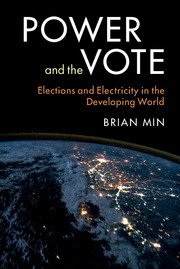Book contents
- Frontmatter
- Dedication
- Contents
- List of Figures
- List of Tables
- Acknowledgments
- 1 Introduction
- 2 Public Goods, Elections, and the Poor
- 3 Power and the State
- 4 Measuring Electricity from Space
- 5 Democracy and Light
- 6 Lighting the Poor
- 7 Electrifying India
- 8 Conclusion
- Appendix Satellite-Derived Estimates of Electrification
- References
- Index
1 - Introduction
Published online by Cambridge University Press: 05 November 2015
- Frontmatter
- Dedication
- Contents
- List of Figures
- List of Tables
- Acknowledgments
- 1 Introduction
- 2 Public Goods, Elections, and the Poor
- 3 Power and the State
- 4 Measuring Electricity from Space
- 5 Democracy and Light
- 6 Lighting the Poor
- 7 Electrifying India
- 8 Conclusion
- Appendix Satellite-Derived Estimates of Electrification
- References
- Index
Summary
At one o'clock as the sweltering sun beat down on India, a load protection circuit tripped on a transmission line near Agra, not far from the Taj Mahal. Instantly, all the power on that line rushed to neighboring lines that quickly overheated, triggering other parts of the network to shut down. As current surged across the crippled grid, load protection circuits flipped like dominoes, cascading across the vast state of Uttar Pradesh, into the Delhi capital region, and soon across all of northern India. Just three minutes later, a final circuit breaker tripped along the Kankroli–Debari corridor in Rajasthan and most of India went dark. On that day, July 31, 2012, some 620 million people lost power. It would be the largest blackout in history.
The outage stretched across nearly 2,000 miles, from India's western border with Pakistan to the Naga Hills it shares with Myanmar. India's vaunted rail system ground to a halt, stranding hundreds of thousands of passengers. In Delhi, traffic signals went out, leading to traffic jams stretching as far as the eye could see.
Indians fumed in frustration as government officials scrambled to restore power and resolve the massive breakdown. The catastrophic failure highlighted an uneasy reality in India. Electricity is a critical public good, undergirding economic production and social welfare. Yet access to the benefits of electricity is anything but universal or assured. Its distribution is an uneven patchwork, connecting fortunate areas to the grid but also passing over millions, leaving more people without power than in any other country in the world. For those with electrical connections, service can be irregular, gone in a moment because of rolling blackouts whose incidence and timing are controlled by bureaucrats and public officials.
- Type
- Chapter
- Information
- Power and the VoteElections and Electricity in the Developing World, pp. 1 - 13Publisher: Cambridge University PressPrint publication year: 2015



